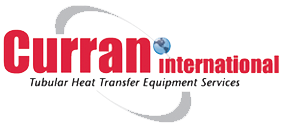Now, More Curran Coatings to Help Prevent Heat Exchanger Fouling
Curran International’s portfolio of coating materials and applications to prevent heat exchanger fouling is expanding.
Advanced materials, targeted for exchangers in crude fouling and slurry services, highlight Curran applications development. Organic hybrid and inorganic coatings provide foul release in crude pre-heat, vacuum bottoms, FCC slurry, and produced water (oil/water) separators.
Very Thin Coatings Work Very Well
Some coatings are functional at just 5-15 microns total thickness and the applied film changes interaction at the substrate; reduces surface tension <30 dynes/cm square, and surface roughness ~.5 microns.

These Curran Coatings reduce surface tension, increase repellency, and promote sheer to contribute to sustained thermal and hydraulic performance.
|
Curramix |
ID, OD, PFE – FCC & VAC bottoms, heavy gas oil, immersion 750F |
|
StreaMax™ |
ID, PFE - resistant to paraffins, asphaltenes, H2S, CO2, immersion 500F |
|
DTI Sol Gel |
ID, PFE – low temperature crude (125F), produced water (194F) |
|
HeatX |
ID, PFE – all cooling water, salt water to 400F |
|
ID – tube ID; OD – tube OD; PFE – Plate Frame Exchanger |
|
The coatings improve “release” and minimize product attachment and foulant nucleation sites. A wide-ranging collection exchanger application installed in field trials ranging 15 to 60 months, shows favorable results against uncoated exchangers in the same service.
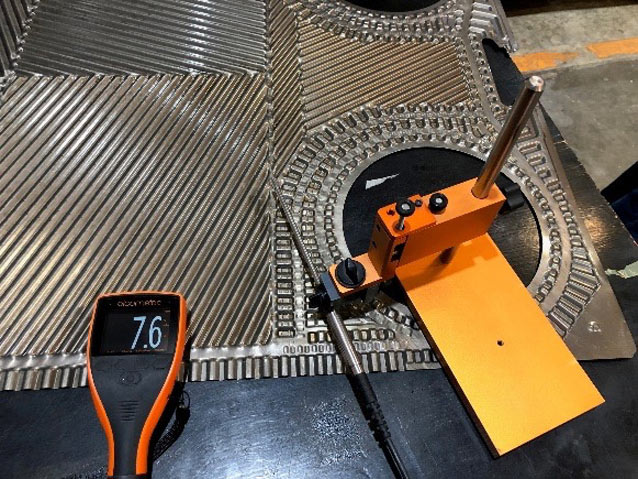
New Materials Help Solve Old Problems
New materials contribute to a growing portfolio of Curran protective tube coatings, facilitating exchanger applications for wider range of refinery and petrochemical services.
These Curran Coating, which are applied at 125 to 300 microns total thickness, offer hydrophobic and oleophobic release, and are suitable for all cooling water services.
|
Curran 1000T |
ID, OD (new/in-service) – cooling water (365F), hydrocarbons, salt water |
|
Durapol TC |
ID – produced water, H2SO4, HCL, NAOH, solvents (check % concentration) |
|
StreaMax, PFA |
ID, PFE – hydrocarbons, solvents, some acids, some services to 500F |
|
Baked Phenolic |
ID (straight tube) - cooling water (365F), some acids and solvents, oxides |
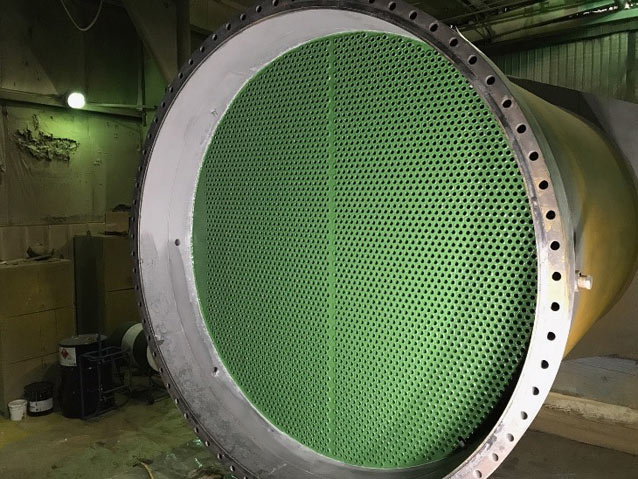
Curran 1000T and Durapol TC can be field-applied and cured, and are suitable for U-tube exchangers. Curran has exchanger application facilities in Houston, Edmonton, Rotterdam and Singapore.
Product Development Continues with Promising Results
New anti-foul coating materials continue to be evaluated. The new anti-foul coatings use materials targeted at high-temperature coking and furnace tube scaling. Preliminary field trials show promising results.
To Learn More
Contact Edward Curran, (281) 339-9993 or ecurran@curranintl.com, for more information about the heat exchanger anti-foul coatings, and our portfolio of heat exchanger coatings.
Advanced Hybrid Materials Reduce Fouling
The use of advanced hybrid materials to reduce fouling of plate and frame exchangers has emerged as a maintenance saving “value-add” for exchangers in critical operating services.
Curran International collaborated with material formulators to develop application techniques for these foul-release coatings. Danish Technological Institute (DTI) developed sol-gel based hybrid coatings. Early demonstrations were conducted with plate and frame exchangers on offshore crude production platforms.
Coated Plate and Frame Exchangers Have Reduced Cleaning Events
Client field trial data shows coated plate and frame exchangers have reduced cleaning events versus uncoated exchangers. In low temperature (60C) crude oil and water separators, coated plate and frame exchangers had increased uninterrupted service from 6 months to 3 years. In another field test, low-temperature crude oil fouling was reduced 30% over a 32-week period between service intervals.
Curran has developed a procedure to facilitate applications, globally, at exchanger OEM service depots, when exchanger disassembly and cleaning maintenance is performed.
Thin-Film Coatings Add Release Performance to Plate and Frame Exchangers
Reduced Annual Maintenance Costs, and Increased Operational Efficiency
These advanced coatings reduce surface tension <30 dynes/cm2; and reduce surface roughness to an Ra of .05 microns. The coatings improve release at the substrate of alloy plate, thus improving release performance. Longer periods between maintenance contribute to operational efficiency, and reduce annual maintenance costs.
Sol-gel hybrid coatings are derived from glass ceramic and organic silanes. These coatings, applied to stainless, aluminum, titanium and Inconel exchanger plates at 5 to 15 microns, resulting in a thin, smooth, low-surface- energy coating.
DTI Sol-Gel formulations for higher temperature applications are being field tested. Curran is also evaluating Curramix 3500 – an organic ceramic-based coating for hot crude and hydrocarbon services.
Very importantly, these thin film applications have negligible impact to heat transfer.
The benefits are:
- Hydrophobic and oleophobic performance
- Optimized release at fluid/substrate interface
- Minimized product attachment and heat exchanger fouling, and
- Improved sheer at normal operation.
Clean Plate and Frame Exchangers Provide the Performance Required
Plate and frame exchangers are favored where operating-unit real estate is limited. Such exchangers are often used on offshore platforms, and in food, dairy and soap industries to evaporate, condense or cool often viscous fluids. As a result of the large surface area of corrugated plates and high turbulent flows through plate configurations, plate and frame exchangers provide thermal duty in an efficient footprint.
These exchangers move fluids through opposing channels on a package of gasketed steel plates. These exchanger designs typically channel fluid between plates having a 2-4 mm gap. To effect heat transfer, product and coolant flow at opposite sides of closely stacked plates. Stainless steel and alloys are used to minimize corrosion.
Over Time Fluid Deposits Collect on the Substrate
On-line cleaning or backflushing are among the preliminary maintenance practices. When more complete cleaning maintenance is required, the plates can be disassembled and cleaned individually. OEMs often have on-site or depot-service solutions for plate and frame maintenance, where cleaning, gasket replacement, and reassembly can be completed.
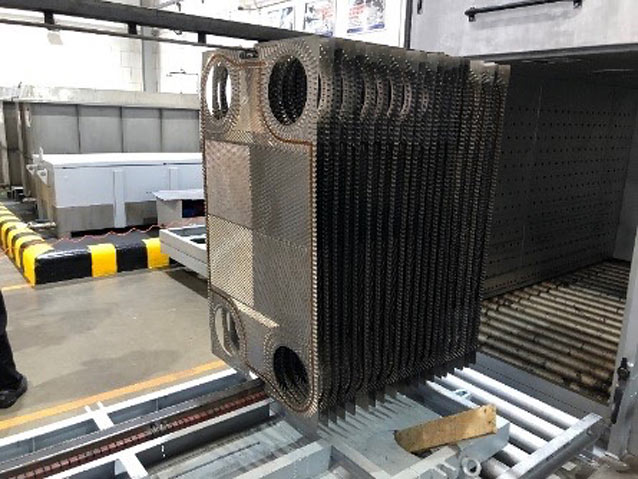
Curran Offers Expert Application of Advanced Anti-Foul Coatings
Coatings can be applied in the field, at OEM plate exchanger service locations. Before coating, in-service exchangers are disassembled and individual plates are cleaned for return to service.
After plate cleaning and prior to re-gasketing, Curran techs prep and apply a release coating, which will be fully-cured prior to reassembly. Gasketed areas are protected from the coating. Following coating, the OEM installs the gaskets.
Put Curran’s Coatings Portfolio to Work for You
Curran’s portfolio of exchanger coatings, and Curran’s application expertise, provide anti-fouling solutions for many types of services.
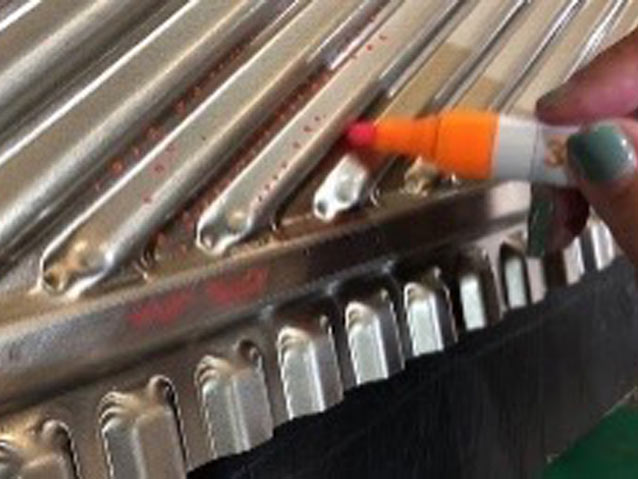
For more information, contact Edward Curran ecurran@curranintl.com or 281.339.9993.
Edward will review your operating conditions and explain the application and benefits of
Curran’s fouling coatings.
Full-Length Alloy Tube Liners Facilitate In-Situ Heat Exchanger Restoration
When corrosion threatens to impact equipment operating-parameters, exchanger alloy tube liners are a proven repair solution.
Curran and hydraulically expands alloy tube liners, creating a full-length
tube-in-tube barrier to ID corrosion.
Alloys C276, 825, stainless steel and CuNi liners have been installed to mitigate new corrosion, and
protect the “as-built” tube bundle. Tubes reman in service, sustaining the thermal capacity of the
exchanger.
Localized Corrosion Can Be Mitigated Using Tube Liners
This is the case, especially where corrosion wall-loss is segregated at sections of an exchanger. Tube liners have been used as an exchanger restoration strategy when clients have directed installation of based on results of tube NDE inspection.
Installation and hydraulic expansion of repair liners can be executed in the field with little deviation from existing maintenance and turnaround schedules. In a retube, replacement tubes must be threaded through baffles. Any tube obstructing the path to subject tubes becomes an added task of the retube scope.
Full-length liners are installed down the existing tube ID, so an area before either tubesheet, about the length of the tube would enable installation. A margin of tube length at extends at both tubesheets for expansion tooling.
Liners Add Corrosion Resistance with Marginal ID Reduction
Liner tube wall thickness is commonly .028” or .035” – but lighter and heavier wall tubes can be specified. Thinner tube liners have obvious benefits for thermal performance and minimize the reduction of tube ID affecting head pressure.
Depending on the liner dimensions and tube material, complete hydraulic expansion is achieved at 6500 to 7500 PSI. The expansion pressure so effectively completes the tube-expansion that the tube ID reduction is limited to the wall thickness of the installed liner.
The ends of the liner are mechanically roller-expanded to seal interface between tubes.
The Single-Contractor Service Strategy
As a full-service contractor, Curran International offers installation of full-length tube liners in-situ. Curran handles tube cleaning prep, as well.
Curran dry grit tube ID cleaning achieves superior tube cleanliness; removing all contaminants and corrosion. This thorough cleaning also facilitates a high- integrity baseline inspection of the existing tube prior to installing the alloy liner. Once a tube has an alloy liner, the original exchanger tube can no longer be NDE inspected.
Full-length liners are then sized to fit the inner diameter of standard sized exchanger tubes. Non-standard liner ODs may require some lead time. In a few instances, the liners can be found in-stock. It is recommended that use of tube liners be a planned repair strategy, or as a contingency for exchangers where “discovery” corrosion is anticipated.
Curran provides a budget-cost for alloy tube liners, hydraulic installation, and a turnkey plan- including tube ID cleaning.
For more information about all of Curran International services contact Ed Deely, 281.339.9993 or edeely@curranintl.com.
Catch Curran
SEO Services by Essential Information Technologies
Copyright © Curran International All rights reserved.
